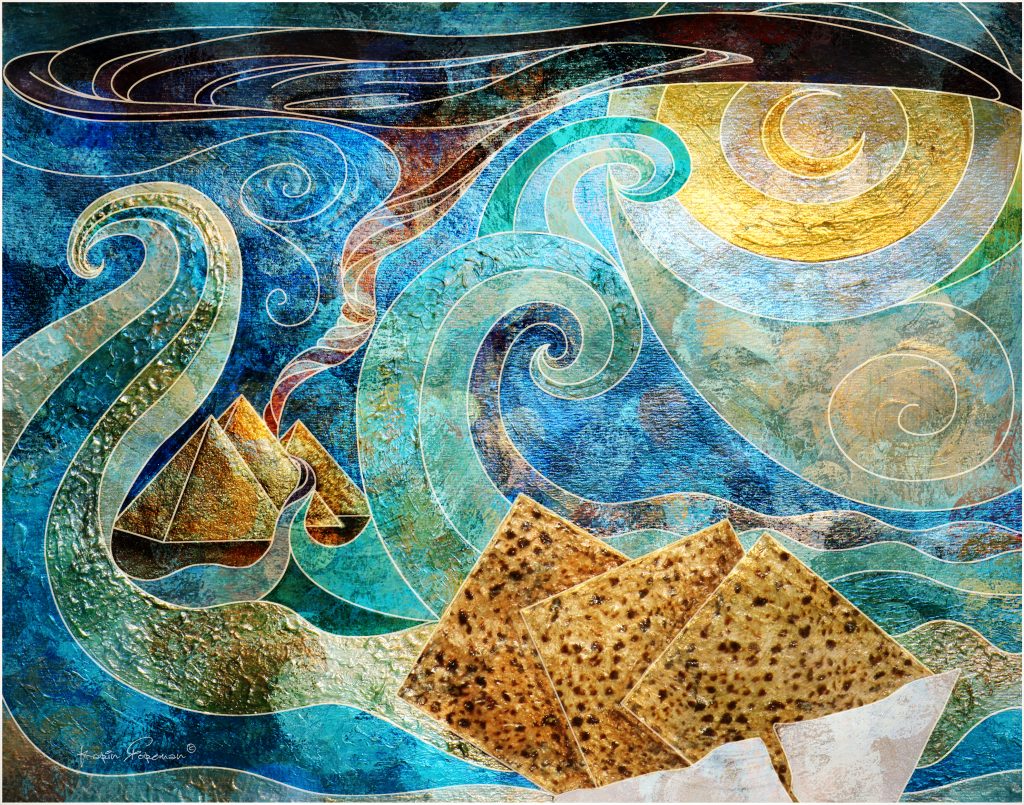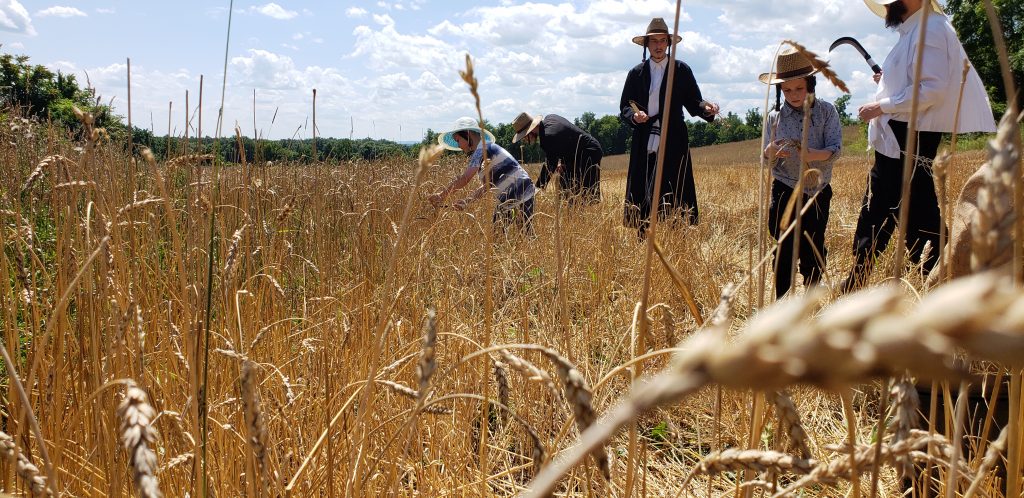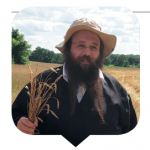
Artwork, entitled Passover, by artist Karin Foreman. Karin explains: “Passover is a mixed media piece made from acrylic, interference acrylic, and metallic paints; super heavy gesso, sand, fibers, and fabric on heavy-weight, acid-free watercolor paper.” karinforeman.com.
Most of us experienced a very different kind of Pesach last year. Due to the pandemic, no one went away. Pesach programs—which serve between 120,000 and 150,000 people annually, according to Doni Schwartz, executive director of passoverlistings.com, a Passover program directory—were all shut down. Compelled to stay home—some with their children and spouses, others with their spouses, still others entirely alone—people found sources of strength and comfort in different ways. Some even discovered a few hidden blessings in the experience, and a lesson or two they hope to carry with them for future Sedarim. Below are their stories.
By Rabbi Benzion Klatzko, as told to Steve Lipman
As a senior manager at North American Olami, a college-based training program, and founder of Shabbat.com, a Jewish social network, I have led communal Sedarim with my wife Shani for almost thirty years, mostly on college campuses, at hotels and other large settings. Thirty to a hundred people generally attend each Seder; a total of approximately 2,000 people have participated over the years.
Last year we realized early on that we would not be able to conduct the kind of Seder we were accustomed to. We had two Sedarim at home, just for our own family and one out-of-town guest who could not go home, a total of nine people. Our dining room table, which can seat sixty-two people, seemed empty.
I didn’t want to lose the magic we had had at our communal Sedarim. At that time, I was also still ill with Covid. It was a tough go.
On the other hand, without the usual big crowd at our table, (often with many who don’t know a lot about Jewish tradition), we had the opportunity to enjoy a longer Seder. We could take our time without feeling rushed.
We encouraged the children to ask questions—beyond the Four Questions, which could be read in a perfunctory fashion. And we really lived the Seder. Everything was for the children.
“Now we have Daddy’s undivided
attention!” they exclaimed. We were able to concentrate on maggid. Our children had time to share all the divrei Torah they had prepared.
The Sedarim were a success—because the kids knew it was theirs.
Rabbi Benzion Klatzko is a senior manager of Olami and the founder of Shabbat.com. He and his wife Shani and their children currently live in Monsey, New York, where (before Covid) they would host eighty or more people for Shabbos. He has been at the frontier of improving Jewish communal life in the United States for over two decades.
Steve Lipman is a frequent contributor to Jewish Action.
By Rabbi Michael Schudrich, as told to Steve Lipman
During the reign of Communism in Poland, Polish Jews gradually lost their traditions. They had no experience in conducting a Seder.
After Communism fell thirty years ago, the Jewish communities around the country began offering communal Sedarim. In recent years, 200 to 250 people attended the main communal Seder in Warsaw, conducted in the Marriott Hotel.
Last year, after the Covid-19 outbreak, we felt that it wouldn’t be safe to have a communal Seder. We decided to use Pesach as a learning opportunity; we would empower people to make their own Seder at home, many for the first time. Our message was, “You can do it.”
We distributed a “Seder in a Box”—complete with shmurah matzah, grape juice, wine, a Seder plate, a Haggadah and directions for conducting a Seder. We recruited volunteers from the Jewish community to bring the “Seder in a Box” to people who could not leave their homes. For some of the volunteers, this in itself was an expression of their Jewishness. Over 200 boxes were distributed in Warsaw. Other communities did something similar. More Polish Jews ran their own Seder at home last year than in any previous year.
This year, if things open up and we are able to hold a communal Seder, we expect to have fewer people than two years ago. Many people may opt to make their own Seder at home; they learned how to do it last year.
That would be a wonderful thing.
Rabbi Schudrich is a Long Island native who has served as chief rabbi of Poland since 2004.
By Alexander Rapaport, as told to Steve Lipman
I was raised in a Vizhnitz Chassidic family in Boro Park. We followed the custom of using matzah baked on erev Pesach for our Sedarim. After burning their chametz, people would come to the synagogue to participate in the communal matzah baking.
It was always a challenge. There was a crush of people, and it was very competitive. Who gets to bake their own matzah? Who gets to keep the matzah after the baking is done? Everyone wanted a piece of the action.
My grandfather couldn’t take the tension; he said the time leading up to the Seder is supposed to be a happy time. Eventually, he decided to get his own oven, and, with much effort, he would set it up in his backyard before Pesach. We baked our matzah that way for many years. When my grandfather died a few years ago, we stopped baking matzah in his backyard.
For a few years, I did not have a set place to bake my own matzah. I found various ovens around town, mainly in other people’s backyards after they finished baking matzah for their own family, which I rented out for a few eighteen-minute shifts.
A year before the pandemic, I went with my sons to Yiddish Farm in Goshen, New York, which is owned by a Chassidic family. We harvested and threshed our own wheat and milled our own shmurah flour. Before Pesach, we rented an oven and baked our matzah using our very own flour.

The Rapaport family harvests wheat at Yiddish Farm in Goshen, New York in 2019. Courtesy of Alexander Rapaport
Last year I decided we would start our own tradition and bake matzah in our own backyard. I heard of a business upstate that sells specialty restaurant equipment, including wood-fired pizza ovens. I purchased a stainless-steel oven with a stone floor, with some custom modifications to suit our needs. It was relatively small but weighed a few tons.
I knew it takes a while for custom-made equipment to be delivered. But then the pandemic broke, and all deliveries were delayed.
The kids were home from school, and we kept them busy gearing up for this big family project. We had harvested about fifty pounds of wheat in the summer and stored the stalks. The children had plenty of activities to do, threshing the wheat kernels by hand the ancient, traditional way.
We waited for the oven to arrive. When the governor announced an impending lockdown two weeks before Pesach, we figured we would not have the oven in time.
But to our good fortune, the oven arrived on Friday, two days before the lockdown began. We set it up in our driveway. There were many halachic and practical logistics to deal with, including building a hut to enclose the oven. My sons did most of the work. I was busy at Masbia, a kosher soup kitchen I run; because of the pandemic, it was the busiest Masbia had ever been.
When baking matzos on erev Pesach, we would always recite Hallel as the Jewish people did while offering the Pesach sacrifice in the Beis Hamikdash, along with other Pesach songs. This year, while baking our matzos, we added songs and prayers from Rosh Hashanah. We were on a spiritual high. We baked matzah for our own Sedarim as well as for several friends and relatives.
At the first bite of matzah at our Seder that night, I cried.
Alexander Rapaport is co-founder and director of the Masbia, a soup kitchen network and food pantry serving over 2 million meals a year in Brooklyn and Queens in New York.
Solo Seder
By R. Rosenfeld
Last year, until a few weeks before Pesach, I believed the virus was a short-term threat and that I’d be spending yom tov with my family. Slowly it became clear that “Solo Seder” would become part of my new Covid lexicon. Would I be able to manage that?
I had been home for chol hamoed in the past, so I had accumulated Pesach dishes over time and knew how to kasher my kitchen. It dawned on me that families or couples who are accustomed to going away to relatives or hotels for the entire week had never truly cleaned or kashered on their own. I thought about recent widows or widowers who would be experiencing their first Pesach without their spouse yet could not be with their children either. All these people faced more hardships than I did.
Still, I was apprehensive, as I had never prepared for a Seder on my own. When I glanced at the calendar and saw a three-day yom tov, the challenge seemed all the more daunting.
I tackled the Seder first. Breaking it down into manageable tasks, I realized there was no need to panic. I wasn’t hosting a table full of guests. Cooking wouldn’t be more difficult than usual. As for what I didn’t have, I improvised. No grater? I bought applesauce for the charoses. My ke’arah was crafted out of decorated small paper bowls. Aluminum foil served in place of a matzah cover, and I found a plastic replica of a stemmed kos.
I have been home alone for three-day yamim tovim in the past, but this time there would be no shul, no meals with friends—no social connection whatsoever. I was accustomed to solitude, but would loneliness intrude?
Then I spotted an online lecture on navigating solo Seders from the OU Women’s Initiative’s Pre-Pesach series. The speaker, Dr. Rachel Levine, offered some really good tips, from planning and sticking to a schedule of activities to asking people to send letters before yom tov that could be read on the holiday. I did so and received my last batch of letters shortly before candle lighting on erev Pesach. I quickly slit them open to savor later on. It was uplifting just knowing they were in my possession.
I did whatever I could to reframe this experience and feel empowered. I dressed up for the Seder, did my hair and makeup and set the table.
I would start on time. It would be neither rushed nor drawn out interminably. I would have just the right mix of Haggadah commentaries, songs and food—since I would be running the Seder. And how many others would have the privilege of greeting Eliyahu HaNavi on their own?
For the first time in many years, there would be no packing, no traveling, no chaos, no sleeping in someone else’s bed. There would be peace.
And there would be gratitude for my blessings.
R. Rosenfeld is a writer who lives in New York.
Seder for Two
By Rabbi Dr. Joseph Ozarowski
Our family Sedarim have been growing smaller for some time. Our kids have gotten married. Three of them made aliyah, giving us eighteen grandchildren. Our state-side kids had obligations to the mechutanim (in-laws). So my wife, my mother and I made the decision to spend Pesach 2020 in Israel with our children and grandchildren who live there. They were eager to have us. We bought tickets on one of the first El Al non-stop flights from Chicago O’Hare to Ben-Gurion.
It was not to be. As the coronavirus set in, things began to deteriorate. The flights never took off. The fear of contagion set in. Shuls and schools began to close. We were told not to go anywhere, even to visit loved ones, and to keep the Sedarim to a halachic minimum.
I could not imagine leaving my mother alone the entire time. My wife, who is an assistant nursery teacher, was very concerned about potentially exposing my mother—a Holocaust survivor—to the virus. After some intense conversation, my wife and I decided on the following plan: my wife would remain home and fend for herself over Pesach, while I would spend the entire yom tov with my mother, both of us sheltering in place.
The Sedarim for my Mom and me did not look terribly different than those of past years, except it was just the two of us. She cooked what she always cooked. I bought the fleishigs she would not eat (my mom’s vegetarian), as well as some kugels. We sang the same songs, had some good discussions, read the Holocaust remembrance prayer we have done every year since I was a child. But it was just the two of us. We ended a lot earlier. And no afikomen hiding.
With no shul to go to, the only way I was able to get by without a minyan was to sing every song in the davening that I could. Singing all the familiar davening songs lifted my heart and soul. I do not think I would have gotten through yom tov without singing.
Rabbi Dr. Ozarowski is a rabbinic counselor and Jewish chaplaincy services chaplain at JCFS Chicago, the city’s major Jewish social services agency. He is the author of To Walk in God’s Ways: Jewish Pastoral Perspectives on Death and Bereavement (New Jersey, 1995).
Dorm Room Sedarim
By Margot Botwinick, as told to Steve Lipman
My husband, Rabbi Josh Botwinick and I work as directors of the Heshe and Harriet Seif Jewish Learning Initiative on Campus (OU-JLIC) at IDC-Herzliya, building Jewish life for hundreds of Jewish students and lone soldiers. Since most of the college students go home for Pesach, we generally do not host a Seder, but take part in a yom tov program at the Dead Sea.
Last year, because of Covid, no one was going home; the students would be doing their own Sedarim in their dorms or apartments, most for the first time. To help our students, we produced a “Herzliya Solo Pesach Guide” that included the basics of the Seder and other parts of the holiday; “Quick Links” for selling chometz online; a “DIY Seder Checklist”; and a guide to “Kitchen Kashering.” We also produced a video of Pesach recipes, and made ourselves available before and during Pesach to answer questions.
The students loved it.
Margo Botwinick and her husband Rav Josh serve as OU-JLIC Torah educators at IDC-Herzliya in Israel.
Visiting In Spirit
By Allison Josephs, as told to Steve Lipman
In a normal year, my family spends the Sedarim with other members of our family, in a hotel or other setting. We also help set up people who grew up Chassidic but no longer identify as such, with other families for the Seders.
Last year was not normal.
We created a pre-recorded model Seder for that people who had never run their own seders could learn how to do it
For our family, conducting a Seder by ourselves for just the six of us was going to be a big disappointment. My children had looked forward to being with their cousins and aunts and uncles. To bring our relatives with us at our Seder table, we printed their faces as life-size cutouts and taped them to chairs at our Seder table. Ten relatives. It lightened the blow.
Allison Josephs is founder and director of Jew in the City, a web site that challenges the public perception of Orthodox Jews and helps promote an accurate understanding of religious Jews and traditional Judaism.
Z’man Cheiruteinu
By Rabbi Efrem Goldberg
Sitting around the Seder table, reciting the Haggadah, observing our customs and engaging guests on the themes of freedom and liberty are a highlight of the year not only for me, but for my whole family. Since becoming a rabbi, my wife and I have hosted Sedarim each year, one for our family and the other with guests. Our Sedarim would go deep into the night and while some participants dropped out at different points in the evening, there was great pride and joy in those troopers who made it to the end.
Like most others, our shul shut down shortly after Purim. While at first we thought it would be for a few weeks at most, it quickly became clear this bizarre reality was the new normal for a while. Not only were we unable to announce and invite to a public Seder, we encouraged families to stay home, not host others and isolate from one another. It was a mindboggling Pesach in which both my parents and in-laws were a few blocks away from us, yet having Sedarim and meals all alone.
While Pesach marks freedom, we all felt like prisoners in our homes. While Seder is synonymous with family, friends and full tables, last year it was characterized by separation, distance and solitude. I had informed the community that I would be leaving my cell phone on and encouraged anyone having dangerous and unhealthy thoughts to reach out, even on yom tov; though honestly, I assumed nobody would take me up on it. During our Seder, my phone rang and my children watched in shock and yet tremendous empathy as I answered and excused myself from the Seder table.
This Pesach I am looking forward to cherishing the wonder of freedom from an oppressive virus, the miracle of liberty from lockdowns.
Rabbi Efrem Goldberg is the senior rabbi of Boca Raton Synagogue in Boca Raton, Florida.
By Naomi Ross
I unpack the holiday bins and dust off the special matzah covers and Haggadahs. I see my shopping lists, cleaning lists and preparation lists. Year in and year out, the rhythm of my Pesach preparations echoes previous years, a comforting familiarity that draws me into the hectic but well-oiled machine of anticipated traditions (laced with a bit of stress for good measure!). With many guests expected and possibly some last-minute surprise guests as well, I shift into quantity cooking and shopping mode. Sleep-in guests and multiple large holiday meals mean lots of food . . . my kitchen is an open tea room.
But not this past year.
“The new normal” descended upon us, and even the most seasoned hostesses felt a bit off kilter. Covid-19 disrupted Pesach 2020 planning . . . for everyone.
I missed the energy and dynamic that guests bring. My kids missed their grandparents and the bonding that happens on a yom tov. The chinuch of Pesach in our home had solidly revolved around the beautiful mitzvos of hachnasas orchim (inviting guests) and the concept of “kol ditzrich” (“Whoever is hungry, let him come eat . . .”). What we did not expect, however, was how the focus would shift in different yet equally important ways. With only my children around the table, we were able to fully concentrate on the mitzvah of v’higadita l’vincha—to educate each of our children about Pesach. With no guests’ needs or attention spans to cater to, there was time to discuss and time to listen, without rushing and without the kids feeling too self-conscious to speak their minds. We were able to give to our kids in the way each of them needed and desired.
With less food to cook and fewer dishes to wash, I was also less tired and worn out. Since it was “just us” at the Sedarim, I set up Shulchan Orech (the festive Pesach meal) buffet style in the kitchen. While less formal, this cut down on serving time and further allowed us to keep the focus on the Seder itself. (Even though I love the elegant regalia of formal serving, this is something I might consider keeping even when the guests return!)
The holidays are my “busy season.” For many years, I reserved the weeks leading up to the holidays for personal chef work for private clients and teaching a schedule of holiday cooking classes as well. This past year, instead of holiday classes to inspire creative menus, I was teaching Zoom classes on how to actually cook and make Pesach for the first time. So many women were overwhelmed and at a loss as to which equipment and essential ingredients they needed to buy, and how to convert certain year-round recipes for Pesach use.
What are the lessons of Pesach 2020? For me, a return to the basics of what Pesach is really about, the centrality of the mitzvah of telling (and listening!) to the story of Yetziat Mitzrayim and the ability all of us have to make Pesach special in our own ways and in our own homes.
Naomi Ross is a cooking instructor and food writer, and the culinary director at Apron Masters Kitchen in Woodmere, New York. Naomi teaches classes throughout the tristate area and writes articles connecting good cooking and Jewish inspiration.



